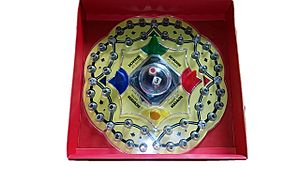Headache (game) facts for kids

Lid of the Game of Headache (UK version)
|
|
| Designer(s) | Kohner Brothers |
|---|---|
| Publisher(s) | Milton Bradley |
| Years active | Since 1968 |
| Players | 2 to 4 |
| Setup time | 2 minutes |
| Playing time | 15-30 minutes |
| Skill(s) required | Strategy, Probability |
Headache is an exciting board game where players try to capture all their opponents' pieces. These pieces are called "cones" or "men." The main goal is to land your cone on top of another player's cone, creating a "stack."
The game involves moving your cones around a circular board. You keep playing until one player has captured all the other players' cones. That player then becomes the winner! There are also special "safe" spots on the board. If your cone is on a safe spot, it cannot be captured by another player. Once a cone is captured, it's out of the game for good.
Just like other popular games such as Trouble, Headache uses a cool "pop-o-matic" bubble in the middle of the board to roll the dice. You press the bubble, and the dice tumble inside. But Headache is unique because it has two dice instead of just one. One die is a regular one, showing numbers from one to six. The other die is mostly blank, but it has a red dot on one side. If you roll the red dot, you get to take an extra turn!
The game Headache was first created in 1968 by the Kohner Brothers. Later, it was made by Milton Bradley. In the United Kingdom, the game was known as Game of Headache and was released in 1968 by Peter Pan Playthings.
Exploring the Game Board
The game of Headache uses a round board. Players move their cones around the outer edge of this board. The "pop-o-matic" dice bubble is right in the center.
Each of the four player colors has its own starting point on the board. The board has a total of 48 spaces where cones can land. Eight of these spaces are special "safe" spots, marked with an X. Four of these safe spots are also the starting points for players. The spaces on the board stick up a little, which helps the cones sit neatly on them.
The board has two different paths, or "tracks." There's an outer track and an inner track. On the outer track, there are three spaces between each 'X' safe spot. On the inner track, there are two spaces between each 'X'. Both tracks join up at every 'X' spot. This design allows players to choose different paths and use strategy as they move around the board.
Safe Spots and Movement Rules
If your cone is on a safe spot (marked with an 'X'), it cannot be captured by another player. Also, opponents are not allowed to land their cones on a safe spot that is already taken. You can keep your cone on an 'X' spot for as long as you want, as long as you have another legal move you can make.
There's one exception to this rule: during the first four turns of the game, each player must move a different cone. This helps to clear the starting spaces so other players can use them.
Understanding Cones and Stacks
The playing pieces in Headache are called "cones" because of their unique cone shape. In the UK, they are sometimes called "men." This special shape allows them to be stacked on top of each other. There's no limit to how many cones can be in one stack!
Each player begins the game with four cones. When one player lands their cone on a space already occupied by an opponent's cone, they capture that opponent's cone. The capturing player then places their cone on top of the captured cone. This creates what is known as a "stack."
Stacks have a cool advantage: they can move around the board in either direction (clockwise or counter-clockwise). Single cones, however, can only move in a clockwise direction. This adds another layer of strategy to the game!


